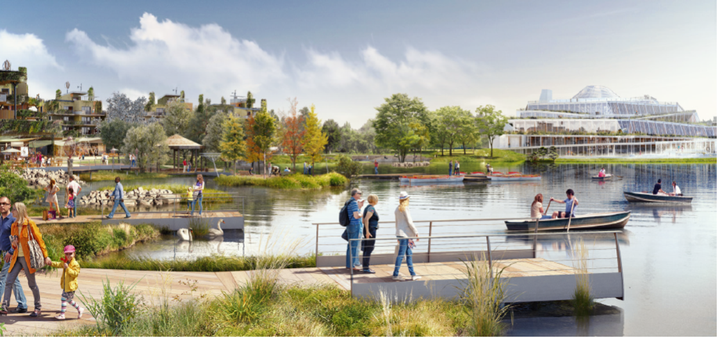
I had just flown into to Charles de Gaulle airport after spending time at the UNWTO Gastronomy Conference in San Sebastian, Spain and was headed to visit the new Villages Nature project just outside Paris.
My hotel informed me I could take their bus for 22 Euros, about an hour to one and a half hour trip depending on traffic. I found there was a second option of taking the TGV Train to the Marne-la-Vallée/ Chessy station for 18.50 Euros with an estimated time of 9 minutes. The train actually took 10 minutes, but was much quicker than the bus.

I was greeted at the station by Frank Hetherton, a Disney Imagineer, and one of the architects and master planners of this new resort. Frank drove me to his offices where we were joined by my colleague Silvia Barbone, director of the PM4SD program (Project Management for Sustainable Development), Marie Balmain, Director of Corporate Social Responsibility for Pierre & Vacances Center Parcs, and her associate Emilie Riess.
We quickly learned of a unique synergy between these two groups that was taking place. Disney who brings a wealth of talent and experience in creating magical, artistic, and imaginary worlds has teamed up with Pierre & Vacances Center Parcs, a development company known for their love for nature, animals, and dwellings in the woods.
The synergy and creativity that these two groups have brought to the creation of Villages Nature is nothing less than a potential game changer for sustainable tourism.
Our tour began with Frank presenting a model of the entire resort. Frank reviewed in detail the master plan of many of the key features and areas of the resort, including the 5 themed areas of the resort, the Aqualagon, the Extraordinary Gardens, the Forest Legends, the Belle Vie Farm, the Lakeside Promenade and its Hanging Gardens.
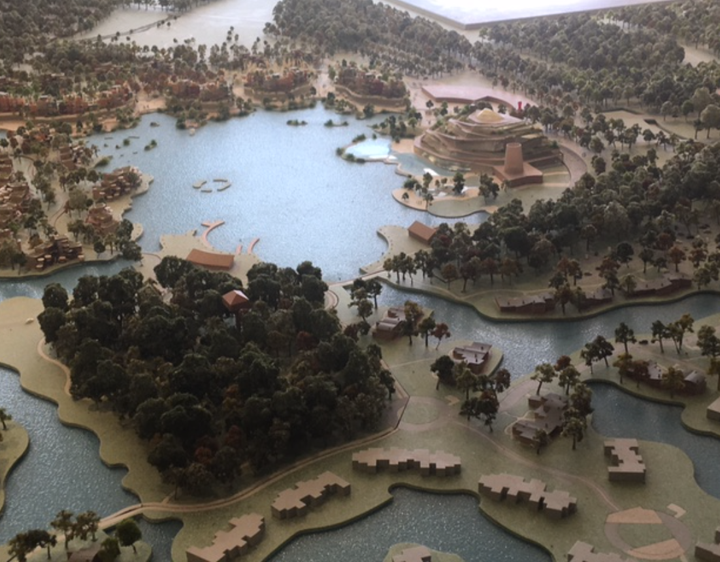
Frank and Marie then shared some of the key sustainable development features of the plan that were created using the One Planet Methodology as a template for this development.
Vision Statement of Villages Nature
“The Vision for Villages Nature is to become an unprecedented reference in eco-tourism on a European scale, both in its resort concept, and its operations.”
Objective of Reducing the Ecological Footprint
“With Villages Nature Paris, Pierre & Vacances Center Parcs and Euro Disney’s objective is to create a tourist destination allowing visitors to live with a single planet during their stay.”
If all humans lived like Europeans the world would need about three planets to satisfy the needs. If the world lived like North Americans it would need five planets. The objective of reducing the ecological footprint of this resort to a single planet can be a game changer for the sustainable tourism industry.
Vision On Sustainable Development
“For Villages Nature Paris, sustainable development is not simply a catalogue of standards (however necessary that might be). Our belief is that we need to go a stage further.
For Villages Nature Paris, sustainable development is an attitude, an optimistic view of the world, born from immersing oneself in nature. This experience has a transformative power: it makes people want to participate and make a difference together, bit by bit, by catching yourself dreaming or imagining a better world at your fingertips …”
“Its fundamental message is to foster harmony and interaction between people and nature. By exploring the many ways in which their meeting one another helps create a new experience, Villages Nature Paris offers a source of emotion, pleasure and discovery.“
Villages Nature® Paris states in its literature that it “also aims to lead the way in reconciling large-scale tourism with the pressing need for sustainable development. It recognizes that leisure activities do not necessarily need to result in the waste of resources or energy, and that the tourist industry provides an excellent opportunity to positively impact the environment and local economy.”
The design of the resort is guided by the ten values listed in the chart below.
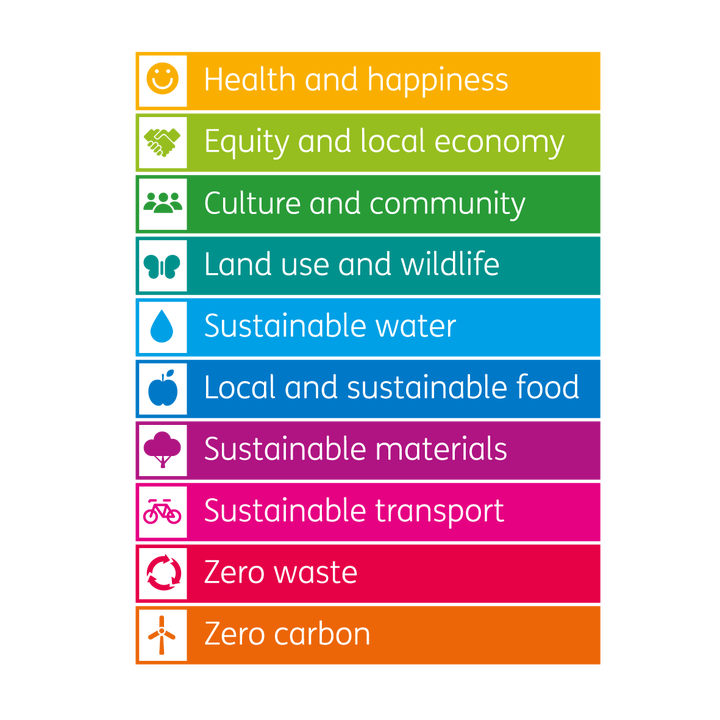
It occurred to me that with the goal of providing leadership in reconciling large scale tourism with the pressing need for sustainable development, it would be interesting to examine how Villages Nature is meeting the challenges of the 9 Planetary Boundaries.
The 9 Planetary Boundaries is an Earth system framework developed by a group of scientists led by Johan Rockström from the Stockholm Resilience Centre and Will Steffen from the Australian National University. In 2009, the group published in the Journal of Nature a framework of “planetary boundaries”. The framework defines a safe and just space for humanity that will allow for just and sustainable economic development, within the limitation of the 9 Planetary Boundaries.
The 9 planetary boundaries include: Climate Change, Ocean Acidification, Nitrogen / Phosphorus overloading, Fresh Water Resources, Land Use Change, Biodiversity Loss, Chemical Pollution, Aerosol Loading, and Ozone Depletion.

While Villages Nature did not specifically plan to address the mitigation of the challenges of the 9 Planetary Boundaries, they have nonetheless developed several strategies to do so.
The following is a list of some of the strategies and metrics that describe how Villages Nature is responding to the challenges of the 9 planetary Boundaries.
Climate Change & Ocean Acidification
These first two boundaries are grouped together since the primary issue is the need to reduce C02. Climate change and ocean acidification are two of our greatest challenges.
Villages Nature Response:
Villages Nature has committed to operate on renewable energy from day one of operations of the resort.
They have employed a number of strategies to operate on just renewable energy. Some of the major ones include:
- Use of passive solar design throughout the resort to reduce the need for heating
- Use of energy efficient appliances throughout the resort
- Use of geothermal as the primary source of its energy supply along with some small wind and solar applications.
- Provides a shuttle connection between the train station and Villages Nature® Paris
- Provides clear communication with guests about the low-carbon travel options
- Provides incentives to favor low-carbon travel options
- 100% renewable energy for heat and hot water of all recreational facilities (including Aqualagon)
- Designed for a “Zero car stay” with green transport onsite and local travel (including bikes and electric car rental)
- The carbon footprint of the building construction is 28% lower than the baseline average
- Zero car site from day one
- Goal for 30% of visitors to make the majority of their journey by public transport
- Policy to reduce embodied carbon during construction of the resort
- Goal of 100% heat demand met by onsite renewable energy from day one thanks to geothermal and green energy contract
- Goal to be net zero carbon by 2020
- Goal to tend toward a “zero cars” site: i.e. prohibit the use of cars inside the site during the stay
- Policy to encourage the visitors who come by car use public transport during their stay when traveling outside the site (to Paris, to Disney Parks, etc.)
- Goal to meet power requirements (lighting, equipment operations) by using other renewable energy sources (currently being studied: wind, photovoltaic, biomass)
- Goal to meet Villages Nature heat requirements using deep geothermal energy, representing a saving of 9000 tons of CO2 per year, and using the same process to cover around 30% of heat requirements for Disney Parks and the Disneyland Hotel
What is quite unique about this project is that it will not only aim to operate as a net carbon zero resort, it will actually be reducing carbon use by providing significant renewable energy to existing theme parks and hotel that will then not use as much CO2 as they currently are using.
Nitrogen / Phosphorus Overloading
The key issue is to reduce the amount of phosphates and nitrates that primarily come from fertilizers which are the major cause of ocean dead zones. Using organic foods is a key strategy. Using local foods makes organic foods more possible and also helps reduce the CO2 by reducing transport needs.
Villages Nature Response:
- Policy to promote restaurants and shops with local and organic products
- Utilize a local farmers’ market
- Policy to encourage outlets to provide a ‘responsible’ and attractive food and drink offer
- Policy to “Favor onsite production and local and regional food”
- Goal to conduct proactive programs to train staff and raise visitor awareness with the objective of making compost from 75% of organic waste (food + green waste)
- Policy to seek partnerships with local farmers
- Program to produce food on site (heated greenhouses, an organic farm, etc)
- Plan to offer sustainable, organic menus at the on-site restaurants (fair trade, vegetarian, vegan, seasonal, etc.)
- Policy to: Procure food supply that will contain at least:
. - 25% of goods produced within a radius of 100 km, - 20% of goods from organic farming,
. - 30% of seasonal fruit and vegetables, an at least 50% of products coming from fair trade . . . (for those that can only be produced outside European latitudes), and no products . . . . . containing GMOs
Fresh Water Resources
Water is necessary to life and many of our rivers, steams, and lakes have been depleted as evaporation and water use is outpacing the replenishment rate.
Villages Nature Response:
- Buildings have green architecture including green roofs
- Target to stay under 132 L/guest/day for the accommodations (Less than the French average daily water consumption of about 275 L per day).
- Goal to reduce Aqualagon water consumption by 48% compared to usual swimming pools
- 37% of the Aqualagon water is cleaned and reused onsite
- Target is to exceed 15% reduction in water use over a comparable baseline
- Goal to reduce domestic consumption by 35% by installing water-saving devices
- Policy to maintain the quality of the aquifer and waterways during construction
- Program to recycle water from the Aqualagon (on track for 37%)
- Program to deploy efficient water-treatment techniques at the water park to help reduce water renewal
- Policy to use only water from the lakes for watering and fire prevention (up to 40,000 m3)
- Policy for design to supply pools exclusively through rainwater and streaming (no intake from underground tables and no drinking water). In the event of droughts, the destination shall comply with general water restrictions. In addition, all water pools will be designed so as to allow for lower levels without compromising the lakeside village concept
- Policy to design pools in such a way as to store water in winter time, to be restored into the natural water network in summer
Land Use Change
Forests, wetlands, and other vegetation types are being converted to agricultural and other land uses. This impacts freshwater supply, carbon and other cycles, and reduces biodiversity. There is a need to protect our wild lands, particularly the forests.
Villages Nature Response:
- All buildings use 100% FSC certified wood
- Maximization of the use of wood, favoring woods of French origin or coming from sustainably-managed forests
- 100% of excavated soil was reused onsite
- Policy commitment to not develop more than 10% of the land
Biodiversity Loss
Stanford professor, Gretchen Daily, states that "it is time to confront the hard truth that traditional approaches to conservation, taken alone, are doomed to fail. Nature reserves are too small, too few, too isolated and too subject to change to support more than a tiny fraction of Earth’s biodiversity.”
Species are being lost at a rate of 100 to 1000 times faster than nature intended. Preserving, protecting, and enhancing biodiversity is part of all sustainable tourism development responsibility.
Villages Nature Response:
- A plan for zero impact for 72 protected species onsite
- A Kids’ club and family nature activity program e.g., gardening, biodiversity discovery and One Planet Living interactive games
- 28,800 trees, and 430,000 plants have been planted onsite.
- Policy to use ecological designing for the pools (by planting reed beds) to improve water quality and preserve the area’s biodiversity
- Goal to maintain limited ground occupancy: less than 10% of built up areas
- Goal to preserve the site’s natural waterways and its zones of ecological value
- Policy to retain the interstitial groves (regenerated and protected)
- Plan to create an ecological corridor and a green space network allowing an unbroken link between all natural areas throughout the resort and towards the surrounding areas
- Plan to create themed gardens and an organic farm
- Policy to develop a flora charter for the site as well as an ecological management plan in order to increase biodiversity without interfering with the existing ecosystem
- Policy to implement fauna and flora observatories, and perform regular monitoring of the number of remarkable species
- Goal to have neutral impact on the 72 protected species identified on the site
- Policy is for ongoing management to be biodiversity positive
Chemical Pollution
Chemical pollution, such as POPS (persistent organic pollutants), heavy metals, and other toxic waste, can lead to potentially irreversible impacts on biological organisms, including reducing fertility, and resulting in permanent genetic damage.
Villages Nature Response:
- Policy that all buildings have eco-labelled and non-toxic paints and floors
- 98% of construction waste was diverted from landfill
- Goal for 100% of waste from tourist operations will be diverted from landfill
- Goal for material recovery rate of > 90%, and > 60% recycling during construction
- Policy to educate guests about importance of waste management
- Policy to promote preventive initiatives to reduce overall waste production (using bulk products, charging deposits on containers, repairing equipment, etc.)
Aerosol Loading
Aerosol particles in the atmosphere impact the health of humans and influence monsoon and global atmospheric circulation systems. Three key strategies to address this challenge include: 1) use cleaner and more efficient technology for energy production; 2) tighten regulations on transportation systems; and 3) reducing or eliminating using dirty fuel in buildings.
Villages Nature Response:
Villages nature is responding to this issue through its cleaner and more efficient energy consumption, encouraging alternatives to auto transportation, and policies to reduce and/or eliminate dirty fuels in its operations.
Ozone Depletion
The stratospheric ozone layer filters ultraviolet radiation (UV) from the Sun. Thanks to the Montreal Protocol this is one planetary boundary where there seems to have been some improvement in recent years.
Villages Nature Response:
No CFC’s will be utilized.
Other Components of the Sustainable Action Plan
Health and Happiness
- Goal to improve wellbeing of visitors and employees through reconnection with nature
- Goal to drive a policy of responsible employment
- Policy for Quality of Life & Well-Being - Emphasize the human dimension of sustainable development by gauging the overall performance of the destination by the satisfaction of our guests, our employees and our neighbors
Equity and Economic Development
- Support the local economy through procurement
- Support local employment in construction and operation
Culture and Community
- Goal to create a transformational experience for visitors to awaken them to sustainable development
- Goal to develop synergies with the key actors and flagship tourist locations in the local area
- Policy to promote local culture and heritage and educate guests about sustainable development
- Program to set up hiking or excursion programs focused on the discovery of the local culture and heritage
- Policy to promote local products, for instance products labelled “Products and Terroirs from Seine et Marne” in the site’s restaurants and shops
- Policy to maximize spending within a 100-km radius
- Policy of open partnerships with local players
- Policy to foster job opportunities as well as economic, social and fiscal benefits for the inhabitants in neighboring areas. All facilities will be accessible to the mobility impaired
After the presentation and overview with the project models, we put on hard hats, vests, and boots and followed Frank on a tour of the site.

During our tour and conversations I was impressed with the seriousness that Frank, Marie, and Emilee demonstrated in their commitment to sustainability. More impressive than this commitment to sustainability for me was the quality of human beings involved in the leadership of this project.
One example was a story that Frank shared with me of the concern that the local neighboring village had that a resort of this size would potentially be an eyesore and disruption to the quality and character of life for the local people living nearby. Frank met with the local mayor to listen to his concerns and seek collaborative solutions. The Mayor raised the concern that a project of this scale could be a visual eyesore to his local community. Frank, asked the Mayor what the tallest building in his village was. The mayor responded that it was the Church steeple. Frank then pledged that the Villages Nature project would commit to not exceeding that height anywhere in the development. Frank and the mayor shook hands and a collaborative relationship continues.
It is hard to put a value on quality human beings that seek collaborative solutions with others. I know from personal experience in other development projects that this is not something taught in schools but something that comes from the personal development of the individual human being. Frank, Emily, and Marie all impressed me as a quality human beings who are also dedicated to sustainability and service to others. With that combination, I think that this project has a high probability of success.
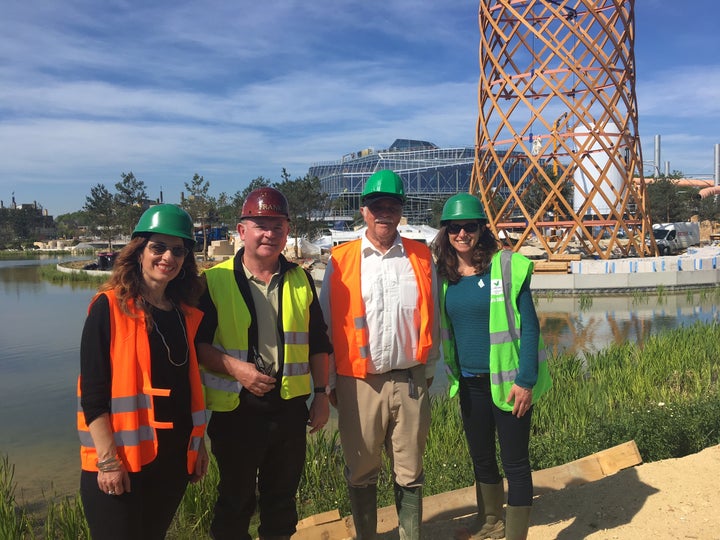
The rather remarkable achievements for sustainability that Villages Nature has already accomplished and plans to implement, is only part of the story. The other part has to do with the actual design of Villages Nature and the programs it will offer.
Joe Rohde, Walt Disney Imagineer and Vice President of Creative, who has been working on the design of Villages Nature talks about the goals of creating a poetic idea using visual metaphors of the garden, and the geothermal, to create an aesthetic experience that will better guide us to a positive future that will provide inspiration to us all. Watch Joe Rohde explain in his own words.
As Frank guided us through the construction he described how he and his team envisioned the 5 themed areas of the resort, the Aqualagon, the Extraordinary Gardens, the Forest Legends, the Belle Vie Farm, the Lakeside Promenade and its Hanging Gardens would come to life.
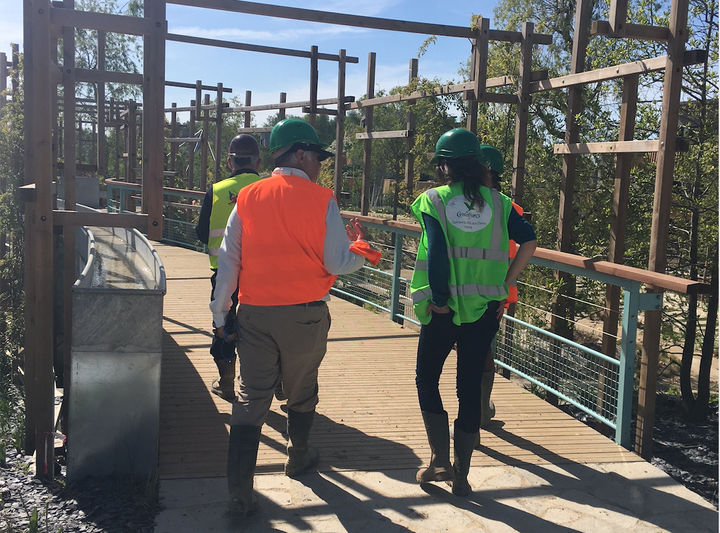
As we walked through the property Frank had a way of making the five areas of the resort come alive even though some of the construction was still going on.
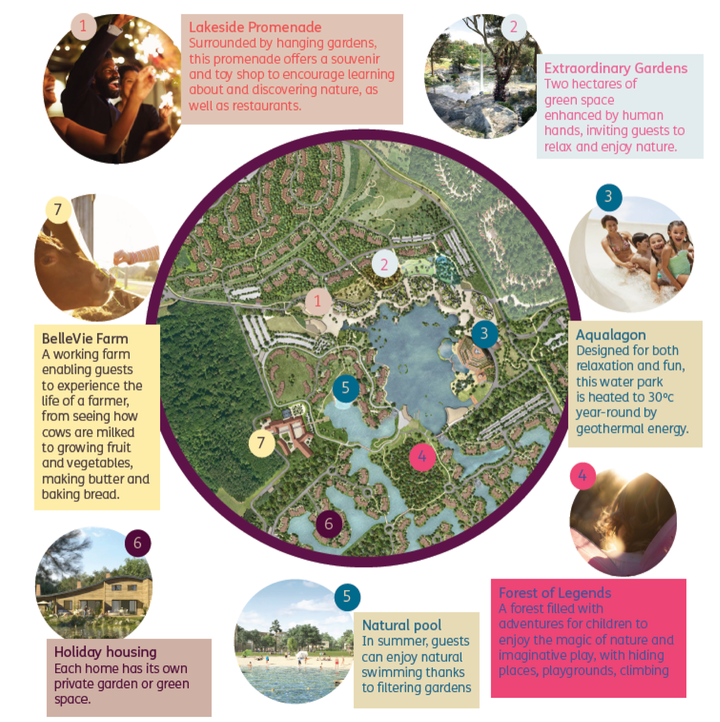
The centerpiece of the Villages Nature resort is the Aqualagon.
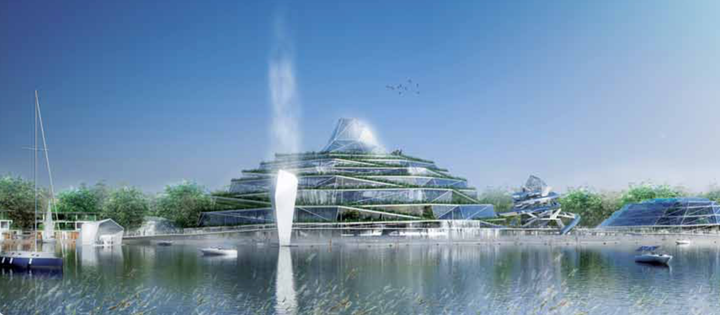
The Aqualagon is a water park within the Village. It includes 7 water slides, a wave pool, an indoor 9000 square meter water park, and 2500 square meters of outdoor lagoon., The water is heated by geothermal to 30 C or higher year round (86 F). Activities for guests in the Aqualagon will include aqua bikes that allow you to pedal underwater accompanied by great music, aqua workout classes, and aqua gym exercise sessions.
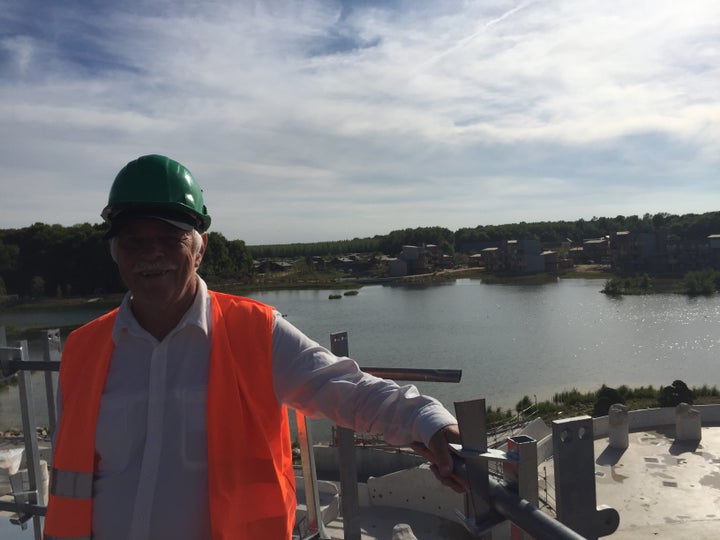
As impressive as the Aqualagon structure is, it was only when I climbed the construction ladders to get to the top that I fully appreciated what the vision of this water slide is to be, plunging 15 some meters into the geothermal pool below.
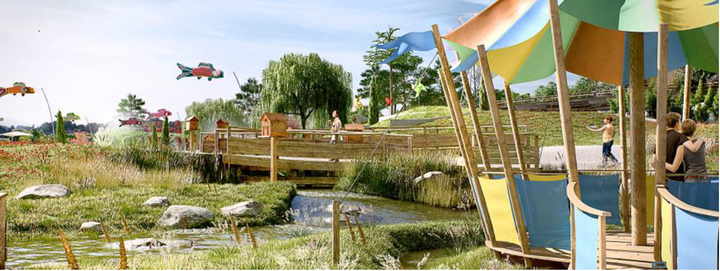
The Extraordinary Gardens are two hectares of gardens in themed areas representing Earth, Air, Fire, and Water. Guests are invited to enjoy the botanical surprises of the Earth Gardens, an evening by the Fire with music in the Fire Gardens, the tinkling sounds created from the wind and breezes in the Air Gardens, and the sounds and spray of the waterfalls in the Water Gardens.

Villages Nature artists also have created mystery pieces in each garden for guests to discover and enjoy. The artists are on hand to share their work and provide tips for interested gardeners who want to create their own magic back home. Guests are also invited to wander through the different gardens and enjoy games that are themed with the different gardens. For families there is a treasure hunt adventure to learn the secrets of the gardens.
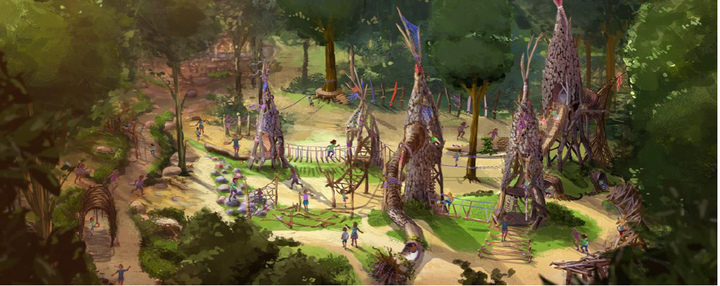
Legend of the Forests is the opportunity to allow guests to join in the story. Once upon a time, a gateway was opened in the forest. It connects the human world to the magical world of the forest land and the creatures who dwell there. To keep the portal open guests are invited to use a booklet and solve the riddles and games to obtain the five keys to keep the portal open.
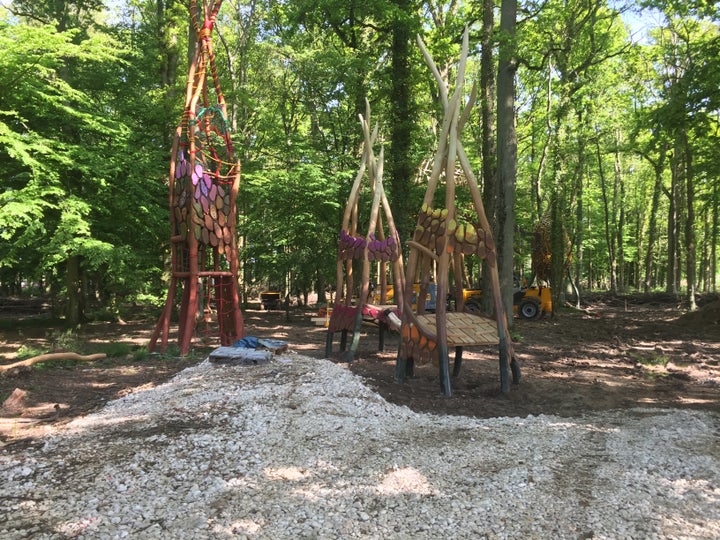
As we walked through the Legends of the Forest it was easy to see how imagination and connection with nature will be sparked in children and adults alike.
Forest of Legends also offers kids and their families opportunities to build their own huts in an enchanting setting, and to work together to decorate them. An instructor will guide the process and families that want can enter their design in a friendly competition. There is also an opportunity for people of all ages to create their own land art in the forest studio and share their work with guests in the Art Gallery.
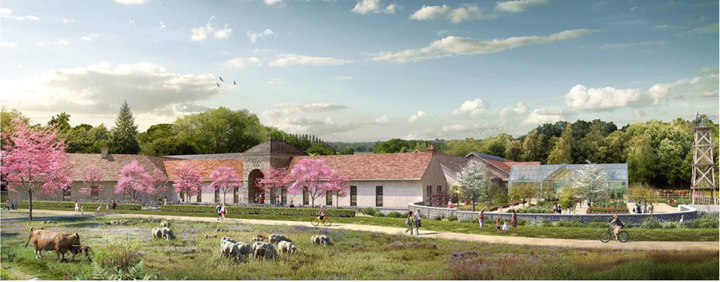
The Belle Vie Farm offers guests the opportunity to get up close to the world of farming, including the animals, vegetable gardens, greenhouses, and more. Guests are invited to participate in a number of activities including the “From Grain to Bread” tour, learning the secrets of bread making, and themed cooking classes with seasonal recipes, and an animal care program to learn how to feed and care for animals.
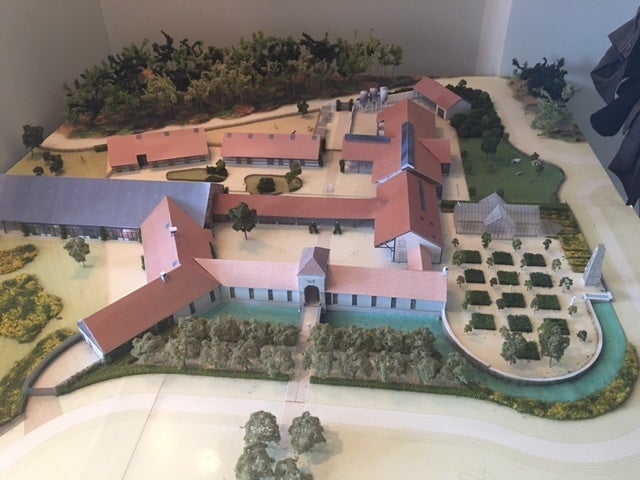
For many guests, this may be their first time to see a farm and to learn where their food actually comes from. It will also be an opportunity to learn how to source food more ecologically.
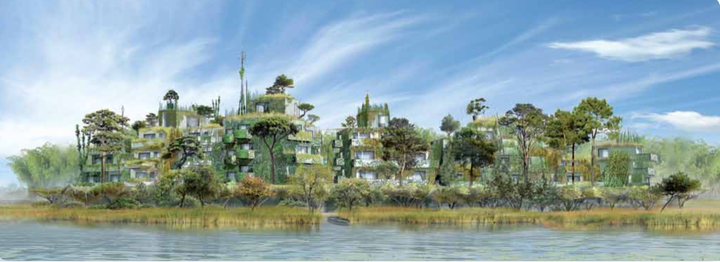
The Lakeside Promenade with its hanging gardens, offers up and coming talent in the amphitheater at the Aqualagon, an introduction to wine tasting and how to pair wines with different foods, and a special “Baby Club” for four month to 3 yr olds, where trained staff have programs to enhance well-being and development. The Promenade also offers restaurants, shops, and excursions to nearby areas and Paris. Click Here for more info
All of this is available with the added bonus of staying in wonderful accommodations.

In summary, the Villages Nature resort is a case study providing evidence that sustainable tourism of the future can be designed to meet the challenges of living sustainably, and with justice within the limits of the 9 Planetary Boundaries. The resort is truly a potential game changer for sustainable tourism that hopefully many will learn from. I look forward to my next visit as a guest. I encourage you to check it out yourself and let me know what you think. In the interim here is a video preview.
Dr. David W. Randle - Director USF Patel College of Global Sustainability Sustainable Tourism, Managing Director International Ocean Institute Waves of Change Blue Community Initiative, and President & CEO WHALE Center.
Follow David Randle on Twitter